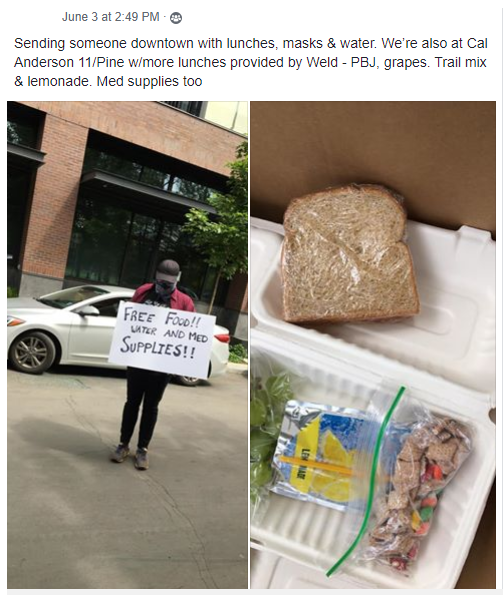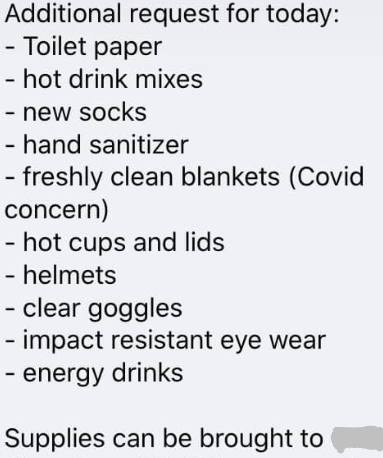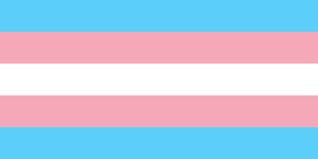Many of us remember what Mr. Rogers told us to do as children when things got scary: “Look for the helpers.” As for adults, we are to be those helpers.
As I watch buildings burn and police turn several kinds of military grade weapons on peaceful protests across the nation (USA), I have been doing both. I’ve been looking for the helpers, and doing my best to be one myself.
Here in Seattle we’ve got Seattle Police Department (SPD), SWAT, and National Guard. Over the past week or so, peaceful protesters have gathered daily at the East Precinct in Capitol Hill, Seattle’s historically gay neighborhood. Police have been using every excuse they can to teargas the crowd, or throw flashbang grenades into their midst, or any one of a number of other weapons that are clearly not intended for deescalation.
We have that on video, thanks to Jessica Frost, who held her phone out of her apartment window above the police line for over six hours to broadcast live via her Facebook profile, where you can find daily recordings. Some of them are also posted to Brandon Frost’s profile as well. Eventually they asked the community for help obtaining equipment. They have gone from one cell phone held precariously out a window to six cameras streaming simultaneously to get more evidence and more views. The Frost feeds are going to be key in future lawsuits and to historians.
Jessica didn’t keep her phone out of the window all night that first night though. She had to close the window to protect herself and Brandon from the clouds of tear gas. You can hear her coughing in the video even with the windows closed.
This picture was taken on June 2 at 7:14am of the streets of Seattle. That’s not fog. That’s tear gas:

Night after night, people have gathered at the East Precinct. Night after night, things have turned violent when the police attacked the protesters with war-grade weapons. Except the tear gas – that may not count as war grade since it’s been banned from use in war by the Geneva Convention. Anyway, night after night, people have regrouped and continued to stand their ground. Leaders have actively worked to keep the crowd peaceful. Protesters work to stop the few who would cause trouble from doing so. You can see all of this on the Frost feeds.
Local to the area, you can find maybe three to six other protests happening on any given day. None of these get much if any attention from the news. None of these turn violent. None of these have any real police response. Go figure. When the police don’t attack, things stay peaceful. SPD has proven daily this week that they are incompetent and violent when it comes to handling peaceful gatherings that they don’t like.
Now of course, all of this is happening because people in America are suddenly taking racism seriously and protesting against it. (If you’re thinking “Racism? What racism?” this article from the Thai Enquirer does a good job summarizing it.) George Floyd may have been the martyr that drew people together, but it could easily have been Breonna Taylor, Tony McDade, Darrien Hunt, or any other number of black Americans to die at the hands of police in the past few weeks. Or any of the over 600 black Americans to be shot to death by police in the last 2 or 3 years. America has a problem, and we’ve decided to fix it. The police don’t like that. It’s probably because they’re part of the problem and, as other writers have said, “they are allergic to accountability.” I’ll get back to this in a moment.
Before this week, I wasn’t sure what an anarchist was. If I’m being honest, I’m still not, but what I have seen in the past week has made it clear that “anarchy” in practice is not equivalent to “chaos,” despite everything I’ve heard about the word from teachers, politicians, and other people who aren’t anarchists. My anarchist friends have told me this repeatedly, but this week I got to see it in action.
As I watched across social media and other platforms, anarchists individually identified needs and choose which ones to fill on their own, all while respecting the Black Lives Matter movement’s leaders. People with medical training set up first aid kits or stations. Some of them asked for medical supplies, food, or water. People with supplies or money provided them. People with vehicles drove the supplies.
People who heard what the leaders wanted passed that information on via several types of platforms so that people could use it to inform their decisions. It’s a large part of why the protests have stayed peaceful; some of the local anarchists heard the leaders wanted a peaceful protest, and have been helping to enforce that up at the police line where the instigators tend to congregate.
Someone with a whole lot of tech savvy coordinated some of the communication and connected people with needs to people with resources. This included coordinating emergency rides and other immediate needs, since 911 is not a reliable place for people who are protesting police brutality and systemic racism to get help. Others with tech savvy backed up the recordings of the Frost feeds to ensure that the police couldn’t eliminate this vital evidence by deleting the posts from the Frost profiles.
All of these efforts combine into moments like the one shown in this Facebook post:

When I asked the person who posted that for permission to post it here, it was happily given. This person also asked me to emphasize that if you wish to provide supplies, make sure they are supplies people have actually asked for. Some people, wanting to be helpful, did not properly coordinate to ensure they were providing things that people actually needed, which meant that this person has gotten stuck with a lot of unneeded items at the end of protests.
On the note of supplies, the supply lists I’ve seen floating around from people asking for donated supplies have things like “water,” “umbrellas,” and “Sharpies” on them. Not one weapon is on any of the supply lists I have seen. Here is one of the most recent supply lists to cross my path. I have hidden the location because on the night of June 7th/June 8th, police or one of the agencies they were working with tossed explosive weapons directly into the medical care area.

Not all of the people I have described above self-describe as anarchists. Many of them do, and several of those who do have been vocal about this kind of community networking and support being part of what anarchy means to them. I have learned from watching this unfold that I do not know what anarchy is. I’m writing about it here because whatever it is, it’s not what the mainstream narrative says it is.
Despite the fact that the protesters are unarmed and the police are fully armored, the police have been acting as though an umbrella is a weapon and have responded with tear gas and other outrageously overblown responses to the point that a pink umbrella has become a symbol of both peaceful protest and SPD violence towards peaceful protesters. Their overreaction to umbrellas and tossed plastic water bottles has prompted a series of memes, one of which found its way onto a protester’s sign:

Let’s get back to the bottom line of what is going on: The USA is built on and was in a literal sense built by a racist system of hierarchical oppression, and people are fed up with it. It is time to make changes that have been needed for hundreds of years. This requires the people in power to lose some of their power, and that will not happen without some kind of fight. That’s what we are seeing. That’s why the police are protecting their precincts instead of the people who would like to see police dismantled, reformed, defunded, and/or abolished. All they need to do to end the violence is stop causing it. Instead, they are attacking people.
Mr. Rogers told us as kids to look for the helpers. Now is our time as adults to be the helpers. That doesn’t have to mean going to a protest, handing out supplies, or providing them as described above. It can also mean writing to your representatives to demand changes, asking your police chief or mayor to step down if you are in a city where police are being violent, or any other number of political actions. You can look at local, county, state, and federal levels and contact every one of your representatives. Every time you contact a politician, it’s like getting a bonus vote.
And, if you are white like me, you may have the most power of all to make lasting change that goes well beyond the correction of police brutality towards people of color, which is only one of the symptoms of the problem. Our minds grew up surrounded by racism. It is not possible to grow up white in America without being influenced into thinking in racist ways even if we do not realize it. We have the ability and responsibility to do the work to learn to recognize that and dismantle it, both within ourselves and for the systems of oppression we live within.
If you haven’t ever thought much about race, now is the time to start educating yourself. If you have already started your journey towards understanding race and racism and your racist family frustrates you but you haven’t had frank conversations with them about it, now is the time to have those hard conversations. We must change the way we as white people think about race and racism to be more in alignment with reality, allyship, and antiracism before black lives in the USA will be treated as though they really do matter. This is the part that isn’t fun, doesn’t show up on news, and can feel the least rewarding, but it is also absolutely vital for any meaningful change to occur.
Also, my dear fellow white Americans, you know that awful feeling you get when someone else who doesn’t know you all that well thinks they know better than you do what you need? Black people are sick and tired of white people trying to tell them how to protest, how to be black, how to go about reaching a place of equality, and so on. We have never been black, so it is ridiculous to think we can know better than they do what it is that they need. Listen to them first before taking actions to support their needs. That way you’ll actually have the information you need to make good choices about your actions.
From something as silly and annoying as bringing unneeded supplies that nobody asked for, to something as serious and racist as accidentally silencing the voices of the people you’re trying to uplift, everything about this will go better if you listen first, then act accordingly. If you’re not used to that, start by following some black leaders on social media, such as John Boyega, one of these bloggers, Senator Cory Booker, and countless others. Find at least ten. Read, don’t comment. While you’re at it, follow some leaders of other races as well. Other axes of racism work differently than the white-black axis, and we need to educate ourselves about all of them.
Here is the Netflix documentary “13th,” free on YouTube, filled with relevant history and context:
Our ancestors did not fix the system. That’s on them. It follows that if we do not fix the system, that’s on us. It’s time to be one of the helpers.
This topic was selected by the author’s Patreon patrons.



